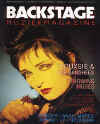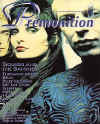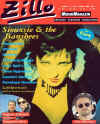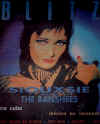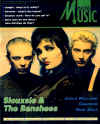 1994:
that unstylish year of boring pseudo-punk, intelligence as a disease,
right wing ascendancy and zero attention span is finally dead. To ring
in the beginning of 1995 in a blaze o f stunning style and rapid wit,
allow me to present some original punks: Siouxsie and the Banshees. The
British press questioned their validity back in 1984, wondering if they
had become "pop stars." Today we clasp our hands and ask: what
ever would we do without them? 1994:
that unstylish year of boring pseudo-punk, intelligence as a disease,
right wing ascendancy and zero attention span is finally dead. To ring
in the beginning of 1995 in a blaze o f stunning style and rapid wit,
allow me to present some original punks: Siouxsie and the Banshees. The
British press questioned their validity back in 1984, wondering if they
had become "pop stars." Today we clasp our hands and ask: what
ever would we do without them?
The ravishing Siouxsie Sioux can always be relied on
for a visual moment. While being given a peek at their new video for 'Oh
Baby' I'm watching Siouxsie watching Siouxsie frown at Siouxsie's
reflection in a lipstick-streaked mirror. The flesh, the image and the
reflection in one frozen second. String scores of those glittering
seconds together and you'll conjure up Siouxsie's long career.
First, there's the flesh and blood Siouxsie, a
glorious woman of startling dark looks and savage humor who looks
younger with each passing year. She must know arcane magic mere mortals
aren't allowed to possess. Then there's images that Siouxsie has danced
in and out of over the years: from brittle blonde punk to dark-haired
diva, she's discarded enough looks to fill a fashion season. This segues
into the many fleeting reflections Siouxsie's left, kept alive through
her fan's [fans'] adoration. Drop by the average Banshees concert and
you'll see creatures emulating ghostly versions of Siouxsie's dark
tresses and glamorous make-up. Hold on: there is no such creature as an
average Banshee's concert, is there? Their concerts are painful,
exhilarating, uneasy, hot and cold, but NEVER average.
The Banshees aren't an average group. That word isn't
in their commanding vocabulary of music. Fronted by Siouxsie since that
fateful 1976 'Lord's Prayer" live performance, the band's other
legends are percussionist Budgie and bassist Steve Severin. Steve's been
Siouxsie's musical half since the band's conception, lending his
sartorial splendor, sardonic wit and powerful songs to their potent
brew. When a song deals with poisonous love and lust check the lyric
credits: they're often Steve's. The quicksilver Budgie signed on after
drummer Kenny Morris fled at the start of a 1979 British tour. He's
stayed put behind the kit, emerging to capture the heart of Ms. Sioux in
one of music's best kept secrets: you knew they were an item but
Siouxsie wasn't one to kiss and tell. If you dared to ask, she'd tell
you to kiss off.
This strong nucleus of voice and rhythm offers the key
to the Banshees' unique sound. The exotic rhythms are perfectly suited
for Siouxsie's deep compelling voice: there's always been an
understanding of her voice and its power. On this new album the strength
of purpose shimmers: after the disappointing Superstition, The Rapture's
confident creativity declare the Banshees haven't gone senile.
The domination of rhythm and voice also explains the
lack of guitar stars in the Banshees. Guitarists have never found a
comfortable home here. This started when the band fired guitarist Peter
Fenton while onstage! Now THAT'S real punk! John McKay, John McGeoch,
the Pistol's Steve Jones, the Cure's Robert Smith, and Clock DVA's John
Valentine Carruthers followed in Fenton's footsteps, although Smith
bowed out due to exhaustion from being in two popular bands at once.
Current six stringer (and former Specimen member) Jon Klein has
triumphed through three albums, which wins him the longevity award. When
the observation is made that Jon has survived due to his good nature and
low-key ego, Steve slyly interjects, "He's got no choice!"
There is a fitting reward for Jon's devotion: Siouxsie, Steve and Budgie
will graciously let him remain in the Banshees and create more music
with them. Siouxsie declares, "If someone is with us it's for a
good reason and if they're not with us it's for a good reason as
well."
They admit to having a sick sense of humor. It
saturates that new video for the deceptively upbeat 'Oh Baby,' The
Rapture's first single. The video features Siouxsie as a contestant in
an actual junior beauty contest filmed in Flagstaff, Arizona. A sly,
Subtly cruel document hidden in a music clip's innocent guise, it's
sheer Banshees in a wickedly mocking fashion. Budgie playfully wonders
if the MTV crowd will get it at all...Budgie is asking the wrong person.
It's a warm December night in New York City, where far
above the city the tangled car horns sound like violins when mixed by
sky and distance. The elegant threesome are exhausted but alert, filling
Geffen's conference room with enough second hand cigarette smoke to
create a fog bank. It's appropriate since the band refers to unusually
quiet Geffen East as the Marie Celeste, the famous ghost ship. It's made
known that the imposing table, which Siouxsie thinks an entire rain
forest died for, is as big as her "not quite a room" at the
trendy Paramount hotel.
Siouxsie's looking tailored and business-like in her
gray vest and trousers, while Steve's sheer-sleeved black shot through
with blue shirt adds the proper touch of glamour. Budgie's in practical
cat burglar black from head to toe: it serves to emphasize his bright
blonde hair. This trio is witty as well as exquisite to the eye: no
ripped jeans and T-shirts here. It's odd how much you appreciate that
quality in a band. They've come an amazingly long way from the tattered
and torn punk look of 1976.
"What HAS happened between then and now?"
mocks Siouxsie at the thought of their first erratic performance. The
amazing growth of a band from grating punkers to divinely decadent
artists is what happened. Tear off the wrappings each year and there's
something new inside every time.
Siouxsie offers, "We always feel it necessary to
sweep away anything that is in the past, and start as if it's your first
record. The only difference is you've got a whole lot of experience!
You've got a lot of situations you've been through that you can draw on,
and I don't know, 18 years, on paper it looks like a lifetime for a lot
o f people out there. Obviously if it felt like 18 years we'd stop and
say it's time to go."
"It also has to do with the fact that we approach
things so intuitively when we're making music that as soon as you look
back on it when it's finished, you're able to use the experience o fit,
like ahh, if we had done that, that was really good, let's push that
side of things forward for the next record. So it's a constant evolution
that we don't analyze if before we go in , we just do it and analyze it
as we go along. We look back and go we could have done that better or
that differently..." explains Steve.
"We are our own worst critics... or best
critics!" amends Budgie with a smile. "We're hypercritical,
and we can't con ourselves... we have tried."
Siouxsie adds, "It also has to feel genuine, too.
We promised ourselves form the beginning that we would never allow what
we do to become a mindless job that you have to keep down. There's no
fear in letting go, and we're still here. We haven't lost our excitement
about what we do. I mean creating something from nothing is the biggest
buzz you can get. We still act like expectant parents every time there's
a new one."
When the Banshees first howled to life they were a
slashing rebellion against a turgid music business. Nothing has changed:
faster and smarter, they're still kicking kaleidoscope fairy dust into
the face of a lumbering giant that's forever trying to pin them down.
"It still IS a turgid business, although it's got
bright new packages and labels. It's been repackaged and
disguised..." mocks Siouxsie.
"There have been some really good things along
the way," interrupts Steve, "but it's still a horrible,
horrible stinking mass of mediocrity in the middle of this business we
work in."
When the Banshees emerged there was no real support
for them. They even had club owners against them due to their disruptive
style. Even though they had to hack their own way out of London's
vicious musical jungle, they still feel the late '70s/early '80s were
much healthier for a truly creative band.
Steve exclaims, "Oh God yes," while Budgie
agrees it's almost impossible for young bands now. Siouxsie fleshes out
the thought, exclaiming, "The pressure to be like the next big
thing is... there was a certain amount of naivete and innocence within
the medium. Certainly music journalists tended to be more fans of music
rather than being careerists or frustrated rock stars themselves."
"That's why you have such a big dance underground
at the moment, because it's easier to create what you want without the
restrictions of being seen as the next big thing. There's also a bit of
fear in it that they don't put their faces on what they do. They can
quietly walk away from that disaster and go on to something else, and no
one really has them down as five minutes of fame and they're out the
door," murmurs Steve, adding he feels that dance scene is already
dying and won't admit it.
As much as the Banshees admired the initial spirit of
the dance underground, they're a traditional guitar-bass-drums band, and
like many other bands they go through the mind-numbing chore of finding
the perfect producer. The Rapture is emitting an added buzz since the
Banshees chose to work with the legendary John Cale, avant garde hero of
the Velvet Underground turned acclaimed solo artist and producer. One
musician declared working with John Cale isn't a challenge since he
kicked his habit. The Banshees didn't find this to be so.
"It was a nightmare," groans Siouxsie
dramatically, quickly laughing. "No, the only question we kept
asking ourselves was why didn't we think him before or SOONER? We've
been huge fans of the Velvet Underground and that was a band that you
were aware it was four individual performers and writers, which was
quite a unique thing. I think it's always been its appeal to people:
there's something more than a bunch of musicians having fun together.
And his solo career, there's been a big journey there."
Steve agrees, adding, "He produced such landmark
albums, too. The first Stooges album, which people still quote today,
the first Patti Smith album, the first Modern Lovers album, so we see
that this is our first album in many ways because of... it's one of
those things that you have to put it down to synchronicity. It was the
right time to work with John Cale. It just happened."
"It wasn't a force, it was just a series of
coincidences. We're still open: I mean you can meet someone tomorrow and
everything can change, it will affect what you are doing," murmurs
Siouxsie.
"Which is the best way that things seem to happen
in a lot of areas. You can try and push something onto people, and say
this has got to take now. But if it's a spontaneous thing that is in the
right place and the right time..." Budgie trails off.
Steve steps in. "The '90s have been good to us.
'91 we had Lollapalooza, '92 we had Batman Returns, working with Tim
Burton, and now '94 with John Cale. And for a jaded old bunch like us,
these things, you feel really excited. 'Oh, we're going to meet Tim
Burton,'" Steve enthuses.
"We're like kiddies again," laughs Siouxsie.
"With a bunch of new toys," adds Budgie.
"It's great. There's no plan to these things,
except now we're trying to look into the future and see what's coming
next year," concludes Steve, spicing his words with a pinch of
sarcasm.
Even though the Banshees seek out those who have
similar outsider tendencies, they admit their plans don't always work
out. Budgie supplies a specific example. "We chose to work with Bob
Ezrin, because of things that we liked, like Alice Cooper's School's Out
and Lou Reed's Berlin. Thinking this could be a wonderful union... but
it didn't work out! It lasted two horrible weeks, and..."
Siouxsie sputters with evil laughter, declaring,
"We sent him on the plane home!"
Budgie nods, adding "So what may seem right just
isn't always so... you can't manufacture it. There's a chemistry within
the group when we write songs, there's this chemistry... there's this
alchemy thing that locks on. The more ingredients that you can get in to
it without fogging the issue, that's the thing that we're always looking
for. This strength of direction that you just tap into. And somehow,
sometimes, it just runs away with you. And you're dragged in with
it!"
"Sometimes things just get missed by chance. For
instance, we would have worked with Brian Eno at one point, but I don't
think we would now. We're beyond that point... what could he give to us,
and what could we give to him? It wouldn't make any difference
now," shrugs Steve.
When Steven [sic] Hague was selected to work on 1991's
Superstition, an immediate alarm went off. His work with fluffier bands
denounced Hague as far too polished a producer for the Banshees,
especially after the experimental plateau they'd reached via Peepshow.
Unfortunately, the recorded results proved the distrust to be
well-founded. There has to be a gracious way to explain Superstition's
lackluster soul: can we be kind and call it an experiment?
Siouxsie instantly replies, "Yes."
"He approached us. He was really keen to do it,
he wanted to do a really great Banshees album," adds Steve.
Siouxsie is willing to explain what exactly went wrong
on that album. She's not hiding her disgust. "We like when someone
is enthusiastic. It's not just oh, here's the next band on his list. It
was like you always hope for this kind of cross fertilization and a
joining of a similar spirit. But this album was a definite reaction
against how we did the last album. Part of answering your earlier
question, part of putting ourselves in a different situation to see what
happens to get a fresh response, well, Superstition was a result of
that. 'Well, we've never done that, OK, we'll see how it goes.' Then
suddenly you're involved with it, and after touring, playing the songs
and then going back to listen to the album, it was so disappointing! 'Oh
SHIT, there's a vital ingredient missing here.' This album, is going
back to that vital ingredient, and that's us, being intuitive, not
compartmentalized and separated under the microscope with tweezers.
It's, as you say, it was an experiment. Sometimes things like that work.
If you don't know what the end result is going to be, then they don't
work. "There was something not quite right: there was a bit of
curdling going on in the ingredients. It wasn't perverse enough."
"These things always work on two levels,"
offers Steve. "There's a collective idea of where you think music
is going, and that's what we took on board with Steven Hague. We felt
that's where it's going, what does it mean to us and how can we use this
approach? And the other side of that is your personal evolution that you
feel. No one could have predicted that as soon as we finished working on
Superstition and as soon as Lollapalooza started, that Nirvana album
would come out and cause such wave thorough [throughout?] all sides of
music, not the least was inspiring other bands to follow a similar
guitar-oriented live thing. So even though it seemed like it became a
dead end anyway, we felt it was a personal dead end, but it drove us to
make the type of album that we made now."
Steve's expression says more than his words when he
quietly describes that people are actually asking the band if this album
is a reaction to the whole Unplugged phenomenon. "Of course not!
It's rediscovering part of us!"
"It's appreciating what we had been
through," scoffs Siouxsie.
There's a certain area of music that the Banshees
excel at: they have that lush, atmospherically dangerous territory
completely staked out. When experiments are conducted, they're fine for
one record, but if the band did it again...
"Fools!" cries Siouxsie.
Steve knows what their audience's response would be:
"You are trying our patience! Just stop it! We'll slap your
wrists!"
"We just did it to confuse everyone out
there," grins Siouxsie.
Yet in America Superstition yielded them many radio
singles and the interest of a new audience via their Lollapalooza dates.
All this from a weak album... what does this tell the band?
Steve strongly defends, "We didn't think it was
because we changed tack [track?] or sidestepped, that it became more
popular than before. To us it just seemed like a progression. For us, we
think that just as many people should like this record, if not
more."
Siouxsie firmly closes the subject by stating,
"At least we realized it. We didn't go tripping merrily down the
wrong path."
They have found their path again. The Rapture regally
bears the Banshees true signature: fiercer bass, unusual musical
elements, exotic topics, and more rage and ruin. The Rapture takes the
wild spirit of classic albums like A Kiss in the Dreamhouse or The Thorn
and updates it. The album's manic closing track, 'Love Me Out' [!]
showcases the Banshees as they should be in 1995: dazzling, dangerously
delicious and different than anyone else.
"It's not cartoon Banshees," agrees
Siouxsie. "It's not how people perceive us. On our journey there's
been one thing that's been part disappointing and part accepted: this
cliche of how people perceive Siouxsie and the Banshees. They're dark,
depressing, morbid, introverted... I am really disappointed with
reviews, when you get... it's almost like you can read the first line
and go 'OK, I read this one thirteen years ago!"
This attitude extends to that vital visual image: fans
are fixated on the image of Siouxsie as 1982's dark queen with her
elaborately teased hair and stark make-up. Too many people have frozen
that goth punk Siouxsie in their memory as their lasting perception of
her. Isn't that getting tiring to the band?
Diplomatically-inclined Budgie has a defense for these
fans. "It's like anything, i f something affects you in your youth,
you always think of that one instance in that artist's development:
that's where YOU remember them from. After that you're not interested in
them anymore. So you will always be that to those people, that
particular point. 'Cities in Dust': from where we were then, it's been a
constant progression for us, but that one image of Siouxsie... it's
ALWAYS from years back. You see it when people come [to shows]..."
he breaks into chuckles, "they're in different parts of where we
were."
"That's quite affectionate when the audience does
that," murmurs Steve. His soft voice gains emphasis when he
continues. "We don't like it when critics or journalists take the
soft option."
"And not even listen to it," retorts
Siouxsie. "They do what they think is expected of them."
"We don't mind bad reviews: it's LAZY ones we
don't like," underlines Steve.
So trust the progressive Banshees to do the
unexpected. In the lazy short attention span theater that makes up the
music scene of the '90s, they're artfully brandishing an epic title song
at us. 'The Rapture' shows the band thumbing its nose at convention and
pouring on the sensuous atmosphere thick and satisfying for an entire
eleven minutes.
Siouxsie exclaims, "We actually got that song
played on 200,000 listener radio station in Rome. It was fantastic! It
was midnight when we went in, and there was this amazing guy who had
this radio show that knew things about us that we'd forgotten about! He
had this family tree, and he was talking about instances that had
happened in the band..."
"We got to 1978 and we said we'd have to come
back to do from 1979 to 1982," laughs Steve.
Siouxsie is completely delighted with this DJ.
"At the stroke of 1:00 he put on 'The Rapture' for eleven minutes!
He said this is probably the only time you're ever going to hear this
track on the radio. We said cheers! Happy New Year!"
There's been this immense suspicion of long songs ever
since the death of progressive rock. Groups like Yes took up entire
album sides with bloated meanderings that staggered and collapsed under
their own bombast. The Banshees were part of the short sharp shock troop
that helped blow that trend out of the mid '70s. So why in 1995 are they
giving it new life?
Steve easily replies, "That's why we did it...
can WE do it? Can WE get away with it? WE'RE reclaiming it."
Siouxsie laughs, "Can we get away with it without
doing drivel?"
The song is also a reaction against feeble
songwriting. "It's the manufacturing of songs that have just become
basically the chorus, verse and just chorus. It's getting more and more
condensed, and it's over," frowns Budgie.
"It's so formulaic," dismisses Siouxsie.
Worse yet, weak songwriters take their trite choruses
and verses and drool them over a five minute song, not realizing the
song died after only two minutes.
Budgie declares, "We know what song you're
thinking of!"
Steve grandly announces, "I am thinking of whole
CAREERS!"
Siouxsie agrees with a healthy laugh, admitting that
'The Rapture' laid the keystone for the entire album. "The idea was
there before we went into the studio. I had the title of the album and
this song before anything else. It was the springboard of where we ended
up with all the other songs."
"It wasn't a concept, it was more like stating
the attitude, the approach, the frame of mind we wanted to put
across," adds Budgie.
Siouxsie explains, "I wanted the cello to be more
up front. It's a much more physical instrument. I wanted the music to
forget about the last album and just realize what we're good at, without
explaining. There's very little debate of what we are, how we are in
this band. It's great when things aren't said but they are UNDERSTOOD.
And after all this time it's how it should be!"
The Banshees are bound to have a silent communication
going on: otherwise they wouldn't be talking about a new album.
Steve grins, "It's silent communication because
we only talk to each other through lawyers!"
That sounds like a worse hell than those evil prog-rock
songs! Another way the Banshees keep their creative resources refreshed
is by their various peripheral projects, from the Creatures featuring
Siouxsie and Budgie to Steve's work with film scores. Side projects
bring in new ideas that lead to improved musical sparks.
"That was even more pronounced this time because
we are working in two different countries now. It's good to get together
and we all go..." Steve growls, supplying a fierce lunge and a
running dialog. "'Have YOU seen THIS?' 'Well why not?' 'THIS is
great.' 'Have you heard THAT?' 'No, THAT'S boring.' 'OK, I'm going
home!'"
Oh well, creative differences: see you next album! But
instead of taking the easy way out and cobbling together an album to
fill a contract, the Banshees took their time with The Rapture. They
knew that coming after Superstition, this one HAD to be brilliant.
Steve details, "On this album we had completed
nine songs and had written and recorded them in France, and we had mixed
that album as of October 1993. The album was due for release, but we
decided that it wasn't ready yet. It's not complete, it's not
ready."
"The record company was there waiting with their
cling wrap wanting to wrap it up an throw it out!" laughs Siouxsie.
Budgie continues, "After that period, we decided
to start more writing, and that's when we started looking around to
bring in a producer. Up until that point we had been doing it ourselves.
We were, I supposed, at that point where you take on a whole new bunch
of ideas as well. We'd been on tour to Australia for the first time in
ten years. We'd been doing live stuff around Europe, playing the songs
we'd just finished. So we were taking on board all those extra
things."
Budgie adds that they didn't hand John Cale completed
songs to merely produce. "We had quite a few songs but things were
also sparked off by having John Cale in the room with us. He's a pretty
inspiring person to have around. He's also pretty scary as well!"
John Cale seems like an intimidating persona.
"Yeah, in this big sort of Welsh way," grins Steve.
Is Steve implying that he's scary beyond how his mind
works? Steve laughs in agreement. "It's the way he looks!"
"Yikes!" yelps Siouxsie." This man is
not Florence Nightingale!"
"No, there is nothing fluffy about him!"
continues Steve.
"Which is what we wanted," agrees Siouxsie.
Budgies stresses, "We don't suffer fools and
neither does John. We were instantly aware that we couldn't con him. We
couldn't go through the motions. We have a language that we've developed
over the years: we can make a few noises and we'll sound like us. But
that's not enough."
Steve admits, "Really he was the first producer
we've ever worked with. Everyone else was more accepting of the pace the
band worked at, always wanting to please..."
It's not hard to imagine a producer being intimidated
by the three of you in full creative throttle. Steve agrees with a
laugh. "Yeah! So it was great to have someone saying get here at
10:00, record, and then you get pumped up and want to do good stuff!
We'd driven ourselves to one limit working without a producer, and being
down in the mouth about the length of time we'd had to be away from the
project,,, so getting someone like John Cale, no, I can't even say
getting someone like John Cale, getting John Cale in... he's like an old
fashioned producer, like you've always imagined they would be. They get
in and do it!"
Not that the Banshees would care, but what was the
record company's immediate reaction to using John Cale?
Steve doesn't miss a second, retorting, "When was
his last hit?"
"That['s] what they said," sighs Budgie in
disbelief.
"There we were, skipping and going 'yes, he wants
to do it,' and the record company was like Steve said, 'is he in the
charts?' It was like..." Siouxsie's elegant jaw drops in remembered
shock.
"Did he produce Kylie Minogue?" laughs
Budgie.
"We were very determined. 'Well, we didn't ask
your opinion but we got it anyway,'" sniffs Siouxsie.
"It's mind-blowing the things that record
companies say to you," murmurs Steve. "You've think they've
said everything then they come along and say something else and your
mouth just drops and you think, oh, the stupidity! You think they've
said it all..."
"Big howls of laughter all the way around, but we
didn't let them know we were laughing," grins Siouxsie. She
abruptly lets loose an amazing caterwaul of laughter. "'Did you
hear that one, waughhhh!' Screaming laughter echoing over the sea and
all around.
"But they kept us sane with the comedy element.
It was always good for a laugh each day with a new name to make you howl
your head off!"
It was good of Polydor, their British label, to make
the Banshees' life so amusing. "It wasn't like that at the
time," grumbles Steve.
Siouxsie threatens, "They were lucky I was in
France. The doors to Polydor would have been kicked in!"
"What's even funnier now is that they wanted to
put out a 'best of' at Christmas, to revitalize the English market! I
said 'yeah that's the only area we're looking at, bloody England!"
mutters Steve.
"We just released Twice Upon A Time! You probably
notice that all these 'best of's' have got one extra track on them from
the best of from last year! It's just repackaged with another title and
it's like the Ultimate Collection!" Siouxsie has a superb
announcer's voice when she puts her mind to it.
"Let's face it, this is where they have been
making their money from over the last few years, reboxing and
repackaging everything on the face of the earth. Glorified CD, digitized
enhancement of the best of the unfound work of... the lost tapes
of..." laughs Budgie.
Steve wearily murmurs, "Most of the record
companies through the 80s spent all their money making bad choices on
bands, and losing lots of money on terrible bands. So what's the easiest
way to play safe?"
"And they're preferably dead," laughs
Siouxsie.
Steve exclaims, "Let's have a look at that
corpse's catalog!"
Siouxsie tops him. "Let's pull up that corpse and
see how much more we can get out of it!"
There's that sick sense of humor! It has helped them
work together after all these years. The band has known each other for
so long that they cheerfully admit they know exactly how to get on each
other's nerves. "And we do it every day!" laughs Budgie.
Siouxsie keeps talking about jumping out of a cupboard
and scaring people half to death. If she launches that evil caterwauling
laughter while in mid leap, heart failure would be certain.
"We are quite wicked with each other!"
laughs Steve.
"Which is why we probably go through so many
guitarists: their hearts aren't very strong!" laughs Siouxsie.
"It's from all that jumping out of the
cupboards!" laughs Steve. "Oh no, I'm in Siouxsie and the
Banshees! I thought it was a nightmare but I am still in the band!"
Wicked, willful and wonderful. Long may they annoy
both each other and their detractors... as long as they still thrill
their listeners!
Sandra A Garcia 02/95
BACK
TO INTERVIEWS/ARTICLES INDEX
|
